Contents
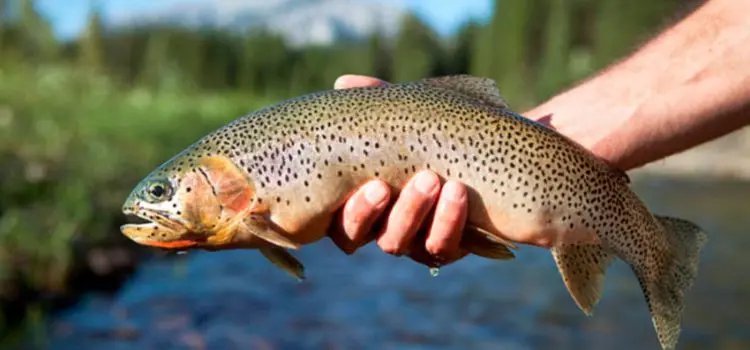
Trout is a rather tasty and very healthy fish, which makes it very interesting both to catch it and to cook it. Trout lives in any water, both salty and fresh, and is found both in the seas, in rivers, and in the oceans, which depends on the variety of trout. Trout habitats have their own characteristics, and this is what we will talk about.
Trout Description
Trout belongs to the family of salmon species of fish and to the order of salmon-like fish.
Color
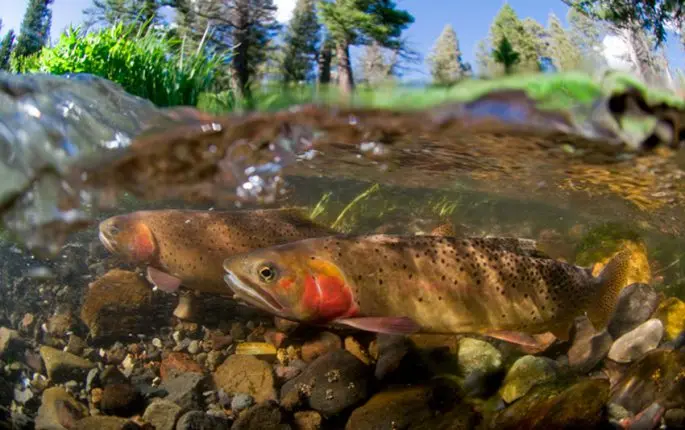
The fish has an elongated body, compressed on the sides and covered with small scales with dark spots. The dorsal fin is short in size.
Trout is able to adapt and change its color, depending on the places where it constantly lives. Here she has some resemblance to the flounder. The back of the trout takes on a color from green to olive, the sides are from yellowish to greenish, and the belly is a gray-white color with a copper sheen.
The fins located on the belly are usually yellowish in color with a large number of dark dots. Trout can be darker or lighter, depending on the nature of the bottom of the reservoir, the shade of the water, the time of year and nutritional habits.
If the trout lives in waters where the calcareous bottom prevails, then the color of the trout will be light, and if it is peaty soils or dark muddy bottom, then the color of the fish will be dark. Depending on nutrition, its color can be monophonic, and the number of dark spots is minimal. This happens when the trout is not limited in nutrition. During periods of breeding processes, the shade of the trout changes towards dark. When moving a fish from a reservoir to a reservoir, its shade also changes. An example is the movement of trout from a wild pond to a paid pond, etc.
How to distinguish a female from a male
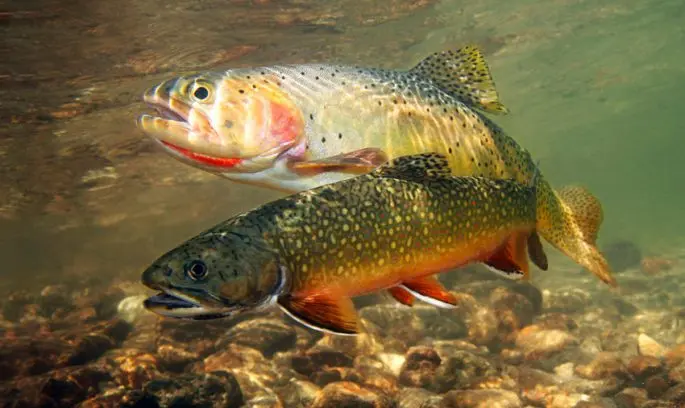
Females are larger than males, but males have larger heads and more teeth. In adult males, an upward bend of the end of the lower jaw is observed.
As a rule, trout reaches a maximum of 1 meter and gains weight no more than 20 kilograms. The average trout has a length of no more than 30 cm and a weight of no more than 0,5 kg. Trout caviar reaches 4-5 mm in diameter.
Trout species

There are such types of trout:
- Lake trout.
- Brook trout.
- Rainbow trout.
What do trout eat
The diet of trout includes zooplankton, larvae of various insects and the insects themselves, as well as small fish.
spawning process
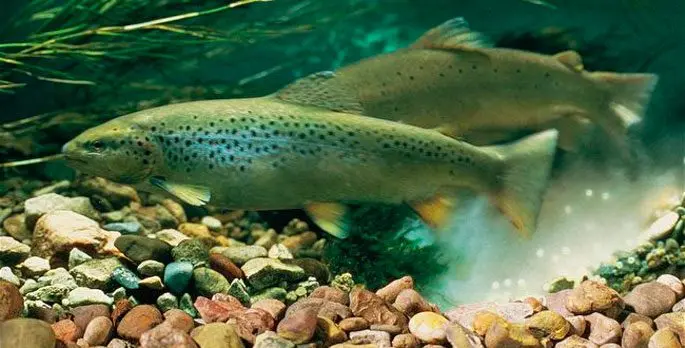
When a trout spawns, it lays its eggs in the recesses that it forms with its tail. After that, the male fertilizes the eggs, and the female buries the depression. After 5-6 weeks, if the conditions are favorable, trout fry appear from the eggs.
Trout traditional habitat
Each species of trout is characterized by its habitats. Regardless of the water body, trout prefer to stay in areas where the water is cool. In areas where the water is actively heated by the sun, you will not find trout, but in areas closed from direct sunlight, as well as at depth, it is found everywhere. The trout leads a flocking lifestyle and is distinguished by shyness and caution.
Lake trout

This type of trout is found in Onega and Ladoga lakes, as well as in the lakes of Karelia and reservoirs of the Kola Peninsula. Some varieties of lake trout are found in the high mountain lakes of the Caucasus and Transcaucasia, such as Lake Sevan and others.
Lake trout lives only in clean and cool water. It can be in flocks, at great depths, from fifty to one hundred meters. If the summer is cool, then trout is found in shallower places located closer to the coast.
Brook trout
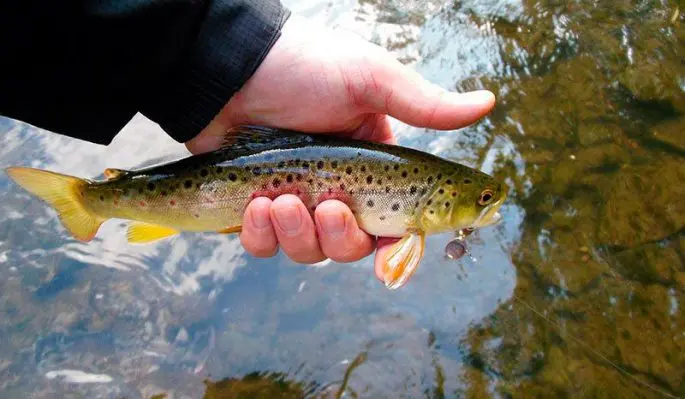
This type of trout is considered an anadromous species, as it lives in both salt and fresh water. Despite this, there are varieties of brook trout that do not leave freshwater rivers and constantly live in the same places. Brown trout fish is considered a representative of the brook trout. She prefers to be in one particular place and does not leave them.
Adult specimens, after spawning, which takes place in autumn and winter, go to deep areas where there are clean springs that constantly bring clean, oxygenated water. Here they catch small fish and stay until the spring.
Particular habitats for trout include areas where there is an influx of clean, oxygenated water. These are places near waterfalls, places near steep banks, near whirlpools, etc., where the bottom of the reservoir is characterized as rocky. In such places, trout keeps in small flocks, constantly migrating from place to place.
Brook trout keeps to areas with a rapid current, as well as places near large stones (boulders), where you can always hide from direct sunlight.
Rainbow trout
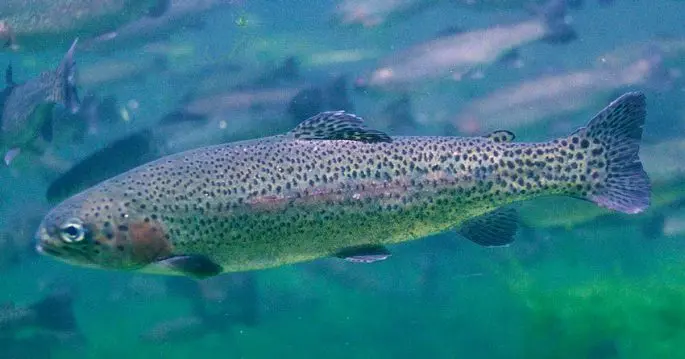
This type of trout is found within the Pacific coast, near the North American continent, where there are reservoirs with fresh water. Rainbow trout is distinguished by tasty, and therefore valuable meat. Therefore, it was artificially moved to the waters near Australia, New Zealand, Japan, South Africa and Madagascar, where it successfully took root.
Rainbow trout are successfully bred in artificial reservoirs in Europe. This is especially true today, when the number of paid reservoirs is constantly increasing. This type of trout prefers clean and cool water, with a temperature of 15 to 20 degrees. She does not like sunlight and tries to hide in snags and among stones. Rainbow trout are most active on cloudy days, including mornings and evenings.
Rainbow trout are not able to stay in water bodies that are covered with a layer of ice for the winter. This is due to the fact that she needs to rise hourly from the depth to the surface of the water in order to fill the swim bladder with fresh air.
Where is trout found in Russia?
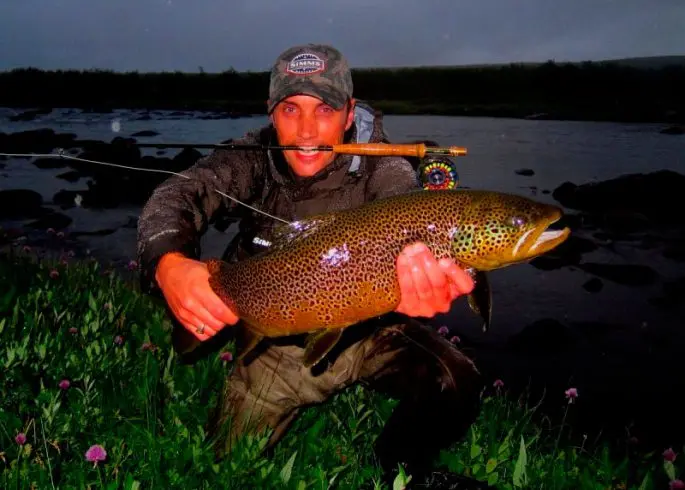
Trout is found in various water bodies that are located closer to the north, as it prefers cool water. For example:
- In Onega lake.
- In Lake Ladoga.
- In the lakes of Karelia.
- In the reservoirs of the Kola Peninsula.
- In the mountain lakes of the Caucasus.
- In paid reservoirs, where it is bred artificially.
Dayfly trout fishing — Kaliningrad region Mayfly fly fishing
Breeding trout in fish farms
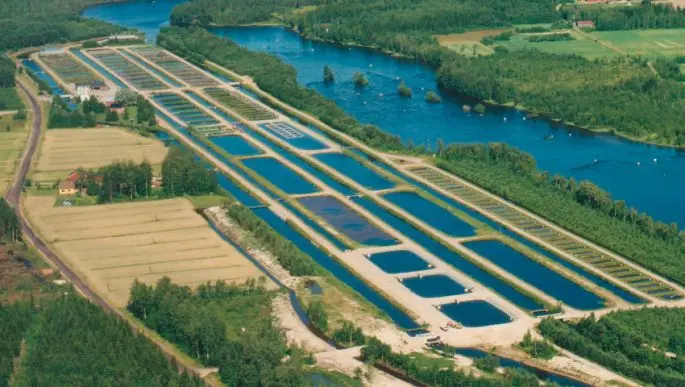
In artificially created conditions, the rainbow trout feels good, therefore, it is bred. All salmon are distinguished by tasty meat and the presence of a huge amount of vitamins and minerals. Rainbow trout is no exception.
Trout meat is especially valuable, so it is bred along with carp and other fish. First, trout is born in special fish farms, where it is fed to such a size that it can be released into open water. In our reservoirs, it is kept and fed to the size when it is caught and sent to the trading network. Paid fishing, including trout, is organized on these reservoirs. Trout fishing is a very interesting activity, so both sports anglers and amateur fishermen come here. They not only fish, but also actively relax, for which all conditions are created here.
Artificial trout farming is widely developed in European countries such as Denmark, Italy, France, etc. Every year they grow up to 170 thousand centners of this delicious and healthy fish. As for Russia, here it began to be artificially grown quite recently. Also, fishing on paid reservoirs has recently begun to be practiced.
If you are seriously engaged in such a business, then from each hectare of the water surface it is realistic to get up to 300 centners of rainbow trout. Unfortunately, everything is not so simple and without observing the technology, nothing will work. Trout are very sensitive to the purity and transparency of the water, which will have to be maintained at the proper level.
Trout fishing features
Trout fishing. Fishing on mountain rivers. Report
Regardless of the conditions in which you have to fish for trout, you need to have certain skills. To catch this beautiful fish, you will have to demonstrate all your skill and ability.
In addition, it will not be superfluous to get acquainted with the nature of the reservoir, learn about its features and the location of promising places. But the most important thing is the availability of suitable gear and catchy baits. If all the nuances are taken into account, then you can always count on the capture of this amazing fish.
Brook trout fishing
Trout fishing. Fishing on a wild forest river. Trout of the Leningrad region.
Brook trout fishing is more actively practiced by anglers, since fishing is carried out in natural conditions. When fishing, it should be remembered that this type of trout is quite shy and cautious. If we take into account that in the river where the trout is found, the water is quite clear, then it can easily notice the silhouette of the fisherman. In order not to frighten the fish once again, it is better to move along the river in the direction of the current. Fishing is interesting because it is quite difficult to catch brook trout. In addition, you have to move along the river, the banks of which are overgrown with vegetation, and this is another serious obstacle.
Fishing for rainbow trout
“Catching rainbow trout, wobblers, hooks, silicone” “Simple about complex” – episode 9
Rainbow trout are not as shy as brook trout, so catching them is not as difficult. It is especially not difficult to catch her on a paid reservoir, where she is mainly caught. For catching it, it is better to pick up brightly colored baits. As a rule, trout bite perfectly on wobblers or red or yellow flies. Rotating lures with bright petals, as well as widely used silicone lures that imitate the movements of various insects, are considered no less catchy.
Lake trout fishing
Catching lake trout on spinning. Part 1
The lake trout is characterized by the constancy of its habitat. This type of trout is attached to the place where there is a sufficient amount of food. Here she can live throughout her life.
Anglers are aware of this circumstance and with great pleasure go to the lakes with the hope of catching lake trout, which in terms of taste is not much different from other types of trout.
Lake trout are actively caught on flies. The main thing is to determine which fly is catching fish at the moment. As many anglers testify, fishing for a larva or a dry fly in clear or running water is considered the ideal option. If the water is stagnant, then a wet fly should be preferred.
Lake trout lives in many water bodies of Russia. At the same time, you should always remember that trout can only be active in clear, clean water. When fishing in still water, it is better to use a wet fly.
When fishing in the summer, it is better to look for trout at a depth where it escapes from the summer heat. It is very important to know the moments when the fish are feeding, then the catch is guaranteed.
How to catch river trout
River trout prefer fast water. Such areas are characterized by cool and clean water, with the presence of a rapid current. In addition, such areas should have a rocky bottom or flooded trees.
What gear is needed?

Trout can be caught:
- With the help of a float rod.
- With spinning.
- With the help of a fly.
It is very important to choose a place where productive fishing is possible. If fishing is carried out on a paid reservoir, then the places are known. If fishing is carried out on an unknown reservoir, then you will have to deal with the definition of productive places.
An equally important factor influencing the effectiveness of fishing is the fishing season, which begins from the moment when the ice disappears from the surface of water bodies.
With the advent of spring, it is better to look for trout in areas that can feed the fish. From the moment when the water level rises and the water loses its transparency, you can forget about productive fishing for trout.
Used lures
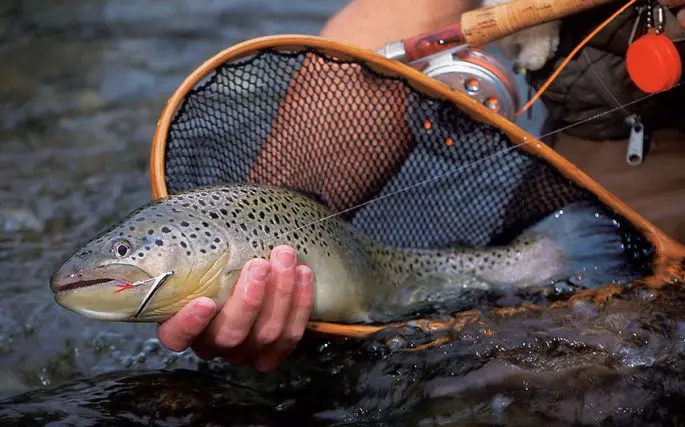
The main lures for trout fishing are:
- Wobblers of various colors.
- Flies, also bright colors.
- The fly is mainly used as bait.
Nowadays, it is easiest to catch trout on a paid pond. As for natural conditions, everything is not so simple here, since many factors are included that affect the effectiveness of fishing.
The main choice always remains with the angler: to fish in nature or in a paid reservoir.









